

Painkillers such as aspirin 'do more harm than good' for chronic pain. Painkillers such as paracetamol, ibuprofen, aspirin and opioids can do “more harm than good” and should not be prescribed to treat chronic pain, health officials have said.
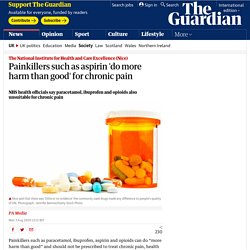
The National Institute for Health and Care Excellence (Nice) said there was “little or no evidence” the commonly used drugs for chronic primary pain made any difference to people’s quality of life, pain or psychological distress. But the draft guidance, published on Monday, said there was evidence they can cause harm, including addiction. The chairman of the guidance committee, Nick Kosky, said that, while patients expected a clear diagnosis and effective treatment, the complexity of the condition means GPs and specialists can find it very “challenging” to manage. “This guideline, by fostering a clearer understanding of the evidence for the effectiveness of chronic pain treatments, will help to improve the confidence of healthcare professionals in their conversations with patients.
Life expectancy in England rebounds after years of stagnation. Life expectancy in England surged in 2019 for both men and women, in a surprise rebound after years of stagnation, according to official government figures.

The Office for National Statistics (ONS) said life expectancy for women at birth increased to 83.6 years in 2019, up four months compared with 2018. For men the increase was three months, taking their life expectancy to 79.9 years. The rises represent the biggest jump since the start of the decade. Longevity improvements in England first faltered in 2011 and had plateaued since 2013, with critics blaming austerity and NHS cuts. Among women, life expectancy fell in both 2012 and 2015. Pills are not the only way to manage chronic pain like mine. I’m writing this column on codeine.
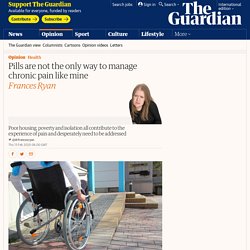
Chronic illness means I’ve been taking painkillers daily for two years, and I’m not the only one: between 2017 and 2018, 5.6 million adults in England were taking opioids; of those, 540,000 had been taking them for at least three years.It’s a strange beast to deal with, permanent illness. Humans are used to acute pain – a stubbed toe, childbirth, a broken arm. We are not designed for lasting pain, the sort that rears its head on an ordinary Tuesday morning and is still there five long years later. We don’t really know how to talk about it, or provide ways of coping. Back from the brink of death: reversing a heroin overdose. The anti-overdose drug naloxone has been around since the 1970s but while heroin and other opioids are easy to find in towns and cities in Britain, this lifesaving antidote hasn’t been.
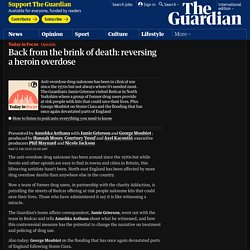
North-east England has been affected by more drug overdose deaths than anywhere else in the country. Now a team of former drug users, in partnership with the charity Addaction, is patrolling the streets of Redcar offering at-risk people naloxone kits that could save their lives. Tracing the US opioid crisis to its roots. In 2015, something happened in the United States that hadn’t occurred there in the past 100 years: life expectancy entered a period of sustained decline.
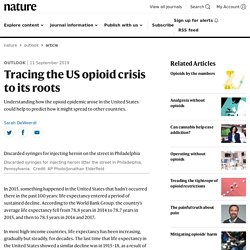
According to the World Bank Group, the country’s average life expectancy fell from 78.8 years in 2014 to 78.7 years in 2015, and then to 78.5 years in 2016 and 2017. In most high-income countries, life expectancy has been increasing, gradually but steadily, for decades. The last time that life expectancy in the United States showed a similar decline was in 1915–18, as a result of military deaths in the First World War and the 1918 influenza pandemic. This time, the culprit has been a surge of drug overdoses and suicides, both linked to the use of opioid drugs. The death rate from drug overdoses more than tripled between 1999 and 2017, and that from opioid overdoses increased almost sixfold during the same period. Reduce UK drug deaths by funding treatment services, experts urge. Drug-related deaths will not come down from record levels unless the government invests in treatment services, experts behind a pioneering project to save lives have said.
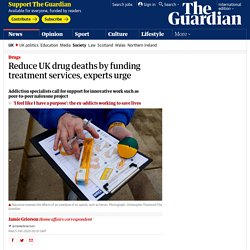
The most recent official figures show that 4,359 deaths from drug poisoning were recorded in England and Wales in 2018, the highest number since records began in 1993, with around two-thirds attributed to drug misuse. Addaction, one of the UK’s biggest drug and alcohol charities, which provides treatment services across the country, is backing a pilot scheme in the north-east of England to bring to the streets a life-saving medication that reverses the effects of an overdose.
'I feel like I have a purpose': the ex-addicts working to save lives. George Charlton’s T-shirt is emblazoned with the words “nice people take drugs” in vibrant neon orange.
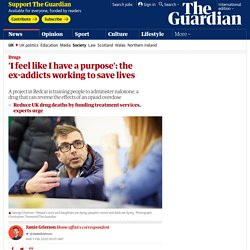
George is sitting in the offices of Addaction, one of the UK’s leading drug and alcohol charities, in Redcar, in the north-east of England, looking out over the town’s esplanade and the North Sea beyond. “I like these T-shirts,” he says. “I like to go into the Co-op on a Monday morning and have someone do a double take and say: ‘Really? Are you mad wearing that?’ It allows us to have a conversation. Pills that kill: why are thousands dying from fentanyl abuse? Natasha Butler had never heard of fentanyl until a doctor told her that a single pill had pushed her eldest son to the brink of death – and he wasn’t coming back. “The doctor said fentanyl is 100 times more potent than morphine and 50 times more potent than heroin.
I know morphine is really, really powerful. I’m trying to understand. Fentanyl overdose deaths. THE roadside billboards in some American towns do not advertise fast-food chains or home insurance.
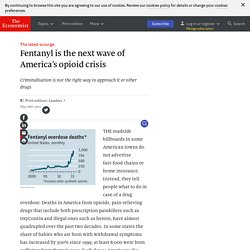
Instead, they tell people what to do in case of a drug overdose. Deaths in America from opioids, pain-relieving drugs that include both prescription painkillers such as OxyContin and illegal ones such as heroin, have almost quadrupled over the past two decades. Increasing Naloxone Awareness and Use: The Role of Health Care Practitioners. The Office of the Surgeon General has released a public health advisory for the first time in more than a decade in response to the alarming escalation of opioid overdose deaths across the country.
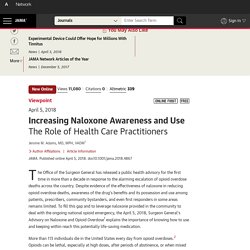
Despite evidence of the effectiveness of naloxone in reducing opioid overdose deaths, awareness of the drug’s benefits and its possession and use among patients, prescribers, community bystanders, and even first responders in some areas remains limited. To fill this gap and to leverage naloxone provided in the community to deal with the ongoing national opioid emergency, the April 5, 2018, Surgeon General’s Advisory on Naloxone and Opioid Overdose1 explains the importance of knowing how to use and keeping within reach this potentially life-saving medication.
More than 115 individuals die in the United States every day from opioid overdoses.2 Opioids can be lethal, especially at high doses, after periods of abstinence, or when mixed with alcohol or sedating medications. McDonald R, Strang J. 'Dose as small as a grain of sand can kill you': alarm after Canada carfentanil bust. It was a carbon monoxide alarm that brought the Canadian authorities to the house in Liatris Drive, a quiet residential street lined with manicured gardens.

As firefighters checked over the house to ensure its inhabitants were safe, something else caught their eye: kilograms of a mysterious powder sitting in the basement. Soon afterwards, the police arrived at the house in Pickering, near Toronto, with a search warrant. They seized 33 identical handguns – and 53kg of the unidentified white and yellow powder. Millions die suffering amid global opioid gap, report says. WASHINGTON (AP) — Nearly 26 million people around the world die each year with serious suffering in part because of a huge gap in pain relief: The U.S. may be awash in opioid painkillers, but they’re rare or unavailable in dozens of poor countries, says a new report. The challenge is to improve palliative care in low-income countries while avoiding mistakes that led to the U.S. addiction crisis. The report to be published Friday in The Lancet says one key is using off-patent morphine that costs pennies a dose — not profitable for drug companies that push pricier, more powerful opioids in rich countries, but critical to easing a health emergency.
In some places, even children dying of cancer or children in treatment for cancer can’t get pain relief, said University of Miami professor Felicia Knaul. Addressing the fentanyl threat to public health (NEJM 2017; 376:605-607) Daily chart: America’s opioid epidemic is worsening. ON TUESDAY February 28th, in an address to a joint session of Congress, Donald Trump vowed to end America’s “terrible drug epidemic”. When discussing America’s social ills, Mr Trump has a tendency to exaggerate. But on the subject of drugs, the president’s characteristically dark and apocalyptic tone may well have been warranted. In 2015 more than 52,000 Americans died of drug overdoses, according to the Centres for Disease Control and Prevention.
That is an average of one death every ten minutes. 2015 was the worst year for drug overdose deaths in US history. Then 2016 came along. What Cookies and Meth Have in Common - NYTimes.com. What the rise in overdose deaths looks like relative to other causes. By Philip Bump By Philip Bump Politics Analysis Analysis Interpretation of the news based on evidence, including data, as well as anticipating how events might unfold based on past events June 10. Globe editorial: How to end Canada’s biggest public health emergency - The Globe and Mail. In 2015, more Canadians were killed by opioid-related overdoses than lost their lives at the height of the HIV/AIDS epidemic. In 1995, at the peak of that earlier public-health disaster, 1,764 Canadians were killed by the blood-borne virus. The latest estimates are that opioids claimed the lives of more than 2,000 Canadians in 2015. And all indications are that the death toll is rising, not falling. Part of the problem may have to do with this: Doctors are not just prescribing opioids, but prescribing them widely and liberally.
‘Opiophobia’ Has Left Africa in Agony. Artist Nan Goldin leads die-in at V&A over use of Sackler name. Report reveals severe lack of services for UK opioid painkiller addicts. Just two free services specifically deal with opioid painkiller addiction in the UK, according to a report seen by the Guardian, prompting experts to warn that there could be a “hidden epidemic” of sufferers. Four big drug firms agree to $260m opioid payout hours before trial set to begin. Four major pharmaceutical companies agreed to a multimillion-dollar payout over the US opioid epidemic on Monday, hours before a landmark federal trial in which they were facing accusations of a conspiracy to profit from addiction and death. How did a town in West Virginia become the opioid capital of the US? A new, virtual tool in the very real fight against opioid overdoses. In addressing the opioid crisis, a team at Penn is piloting a new solution: virtual reality.
Drug makers conspired to worsen the opioid crisis. They have blood on their hands. Drug-poisoning deaths in England and Wales at highest level ever recorded. Scotland's drug death crisis in six charts. Drug related deaths 18 info. Drug-related Deaths in Scotland in 2018. Scotland has highest drug death rate in EU. Image copyright Getty Images New figures released later are expected to show that more than 1,000 people died as a result of drugs in Scotland last year. Scotland has highest drug death rate in EU. Scotland records huge rise in drug-related deaths.
Scotland’s drug-related death toll has increased by 27% over the past year to reach a record high of 1,187, putting the country on a par in terms of the fatality rate per capita with the United States, where synthetic opioids such as fentanyl have devastated drug-using populations. The death rate is now more than three times that of England and Wales, and has more than doubled since 2008, when there were 574 deaths.
It is higher than any other EU country. Scotland overtakes America as the world’s drug-overdose capital - Trainspotting revisited. Scotland has a drugs problem – and it’s called Westminster. Louvre removes Sackler name from museum wing amid protests. Scotland records huge rise in drug-related deaths. The Guardian view on Scottish drug deaths: put health and safety first. Judge dismisses Johnson & Johnson's request to toss out lawsuit over opioids crisis. County lines: the most comprehensive insight you will find. Across the rich world, an extraordinary jobs boom is under way - Working it.
- The Washington Post. Britain risks heading to US levels of inequality, warns top economist. We can't halt drug trade with arrests, says crime agency chief. Prosperity Is So Much More Than Wealth. Op Executives of Insys, an Opioid Company, Found Guilty of Racketeering. Opioid painkillers 'must carry prominent warnings' Opioid painkillers to carry prominent addiction warnings. The Opioid Chapters. Moodle. The opioid epidemic, explained. Brookings. 15078. 'Our country is full': Trump claims emergency during border visit. How the opioid epidemic became America’s worst drug crisis ever, in 15 maps and charts. Weighing the Risks and Benefits of Chronic Opioid Therapy. - PubMed - NCBI.
Opioids compared with placebo or other treatments for chronic low back pain: an update of the Cochrane Review. - PubMed - NCBI. 10. Annualreviews. Relieving Pain in America: A Blueprint for Transforming Prevention, Care, Education, and Research. Bmj. The expanding universe of synthetic drugs - Exploration and desperation. 10. FDA's opioids adviser accuses agency of having 'direct' link to crisis. Significant-Seizure-Fentanyl-Bust-Announced-by-Montgomery-County-District-Attorney-Feds-449272123. Trump says he and China's Xi to try to end opioid crisis. Jamanetwork. Products - Vital Statistics Rapid Release - Provisional Drug Overdose Data. Fentanyl Overtakes Heroin as Leading Cause of U.S. Drug Deaths. Products - Data Briefs - Number 294 - December 2017.
'It's all fentanyl': opioid crisis takes shape in Philadelphia as overdoses surge. Is the US opioid crisis contagious and could Australia be next? The Changing Face of Heroin Use in the United States: A Retrospective Analysis of the Past 50 Years. How cracking down on America's painkiller capital led to a heroin crisis.
Oxycodone Explained. Pharmageddon: how America got hooked on killer prescription drugs. Pills that kill: why are thousands dying from fentanyl abuse? Seizing on Opioid Crisis, a Drug Maker Lobbies Hard for Its Product. Route to recovery: how people overcome an opioid addiction. Amid the opioid epidemic, white means victim, black means addict. Opioid Crisis Affects All Americans, Rural and Urban. Teen Drug Overdoses Doubled From 1999 to 2015, CDC Reveals. Trump Declares Opioid Crisis a ‘Health Emergency’ but Requests No Funds. Laguna Treatment Hospital. Opioid Summaries by State. STAT forecast: Opioids could kill nearly 500,000 in U.S. in next decade.
China cracks down on fentanyl after US pleads Beijing for action on opioids. Can marijuana help end the opioids crisis? Opioid crisis protesters target New York's Guggenheim over Sackler family link. FDA's opioids adviser accuses agency of having 'direct' link to crisis. The making of an opioid epidemic. Left behind: can anyone save the towns the UK economy forgot? Increasing Naloxone Awareness and Use: The Role of Health Care Practitioners.
Fentanyl overdose deaths. 'Dose as small as a grain of sand can kill you': alarm after Canada carfentanil bust. Millions die suffering amid global opioid gap, report says. The bad news is we’re dying early in Britain – and it’s all down to ‘shit-life syndrome’ Globe editorial: How to end Canada’s biggest public health emergency - The Globe and Mail. 2015 was the worst year for drug overdose deaths in US history. Then 2016 came along. Daily chart: America’s opioid epidemic is worsening.